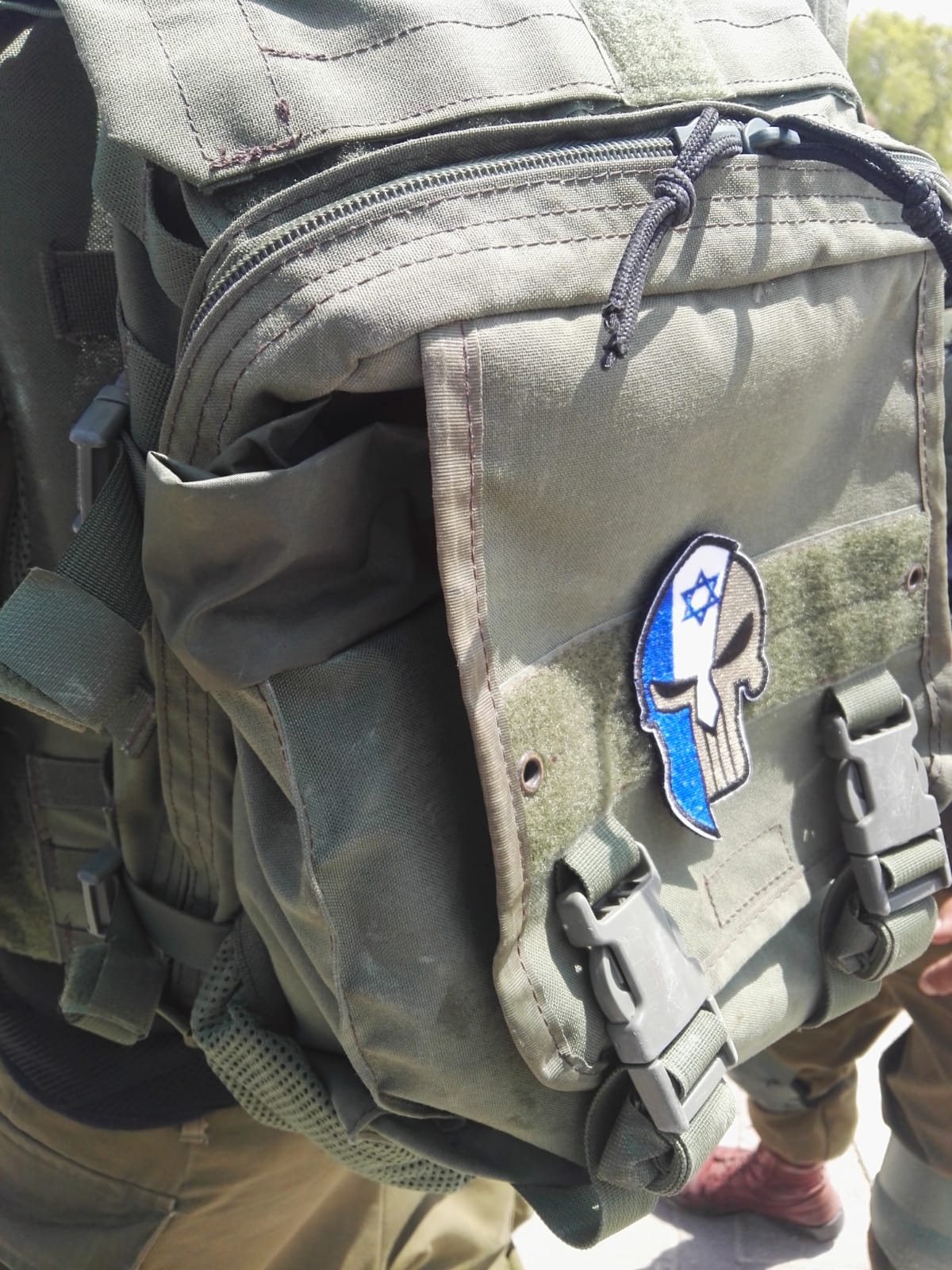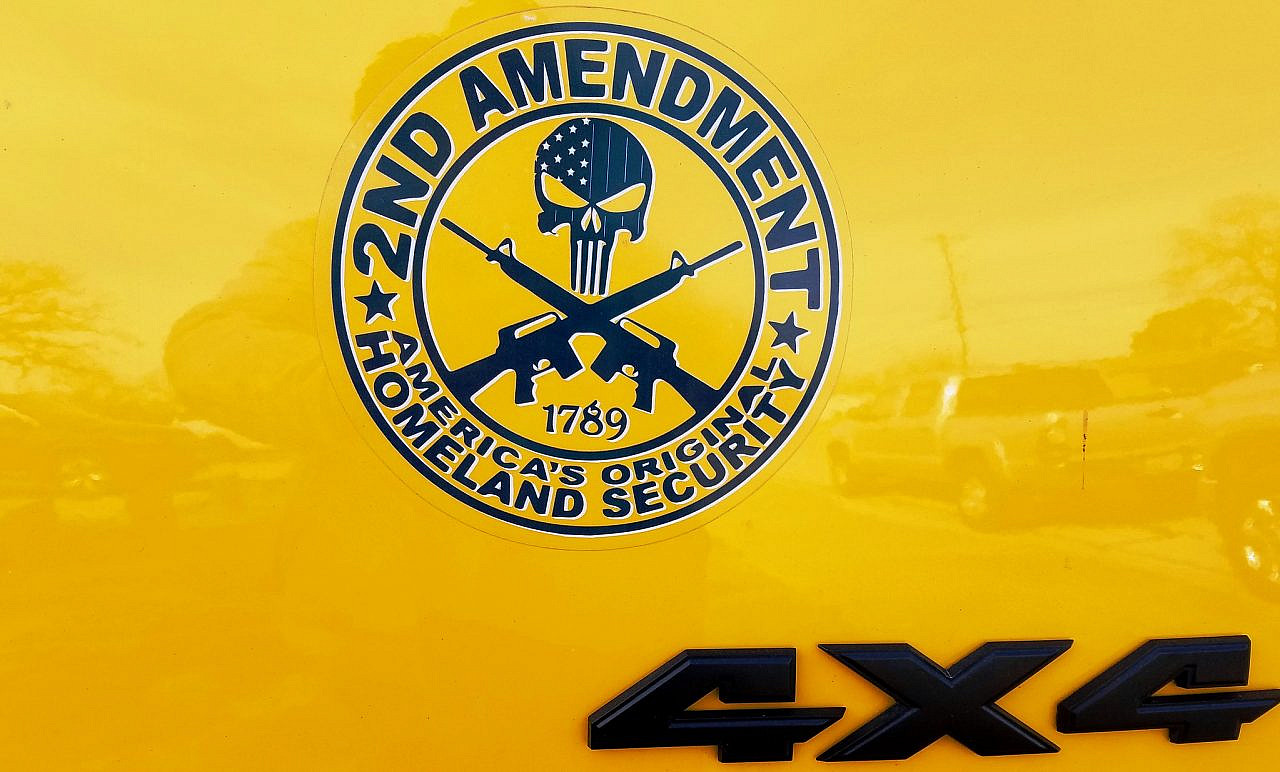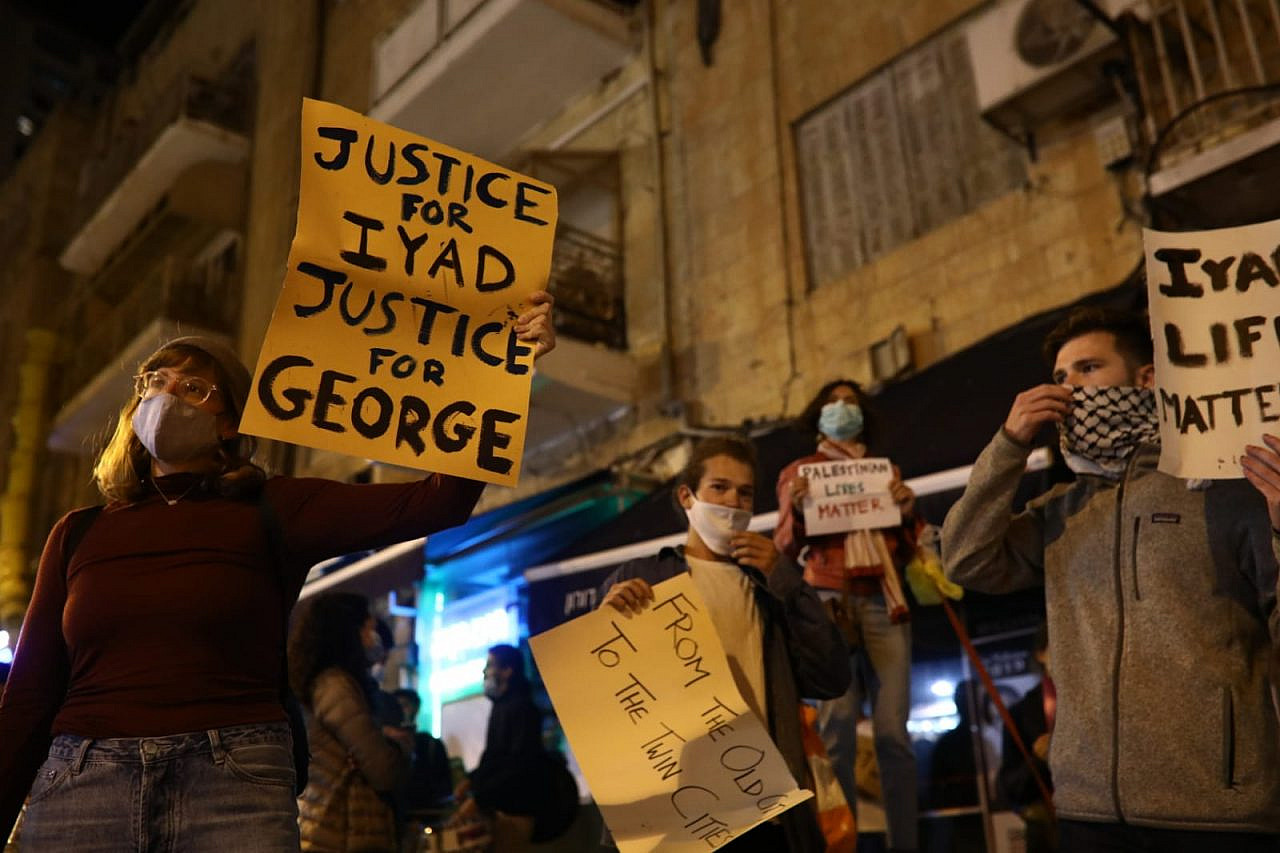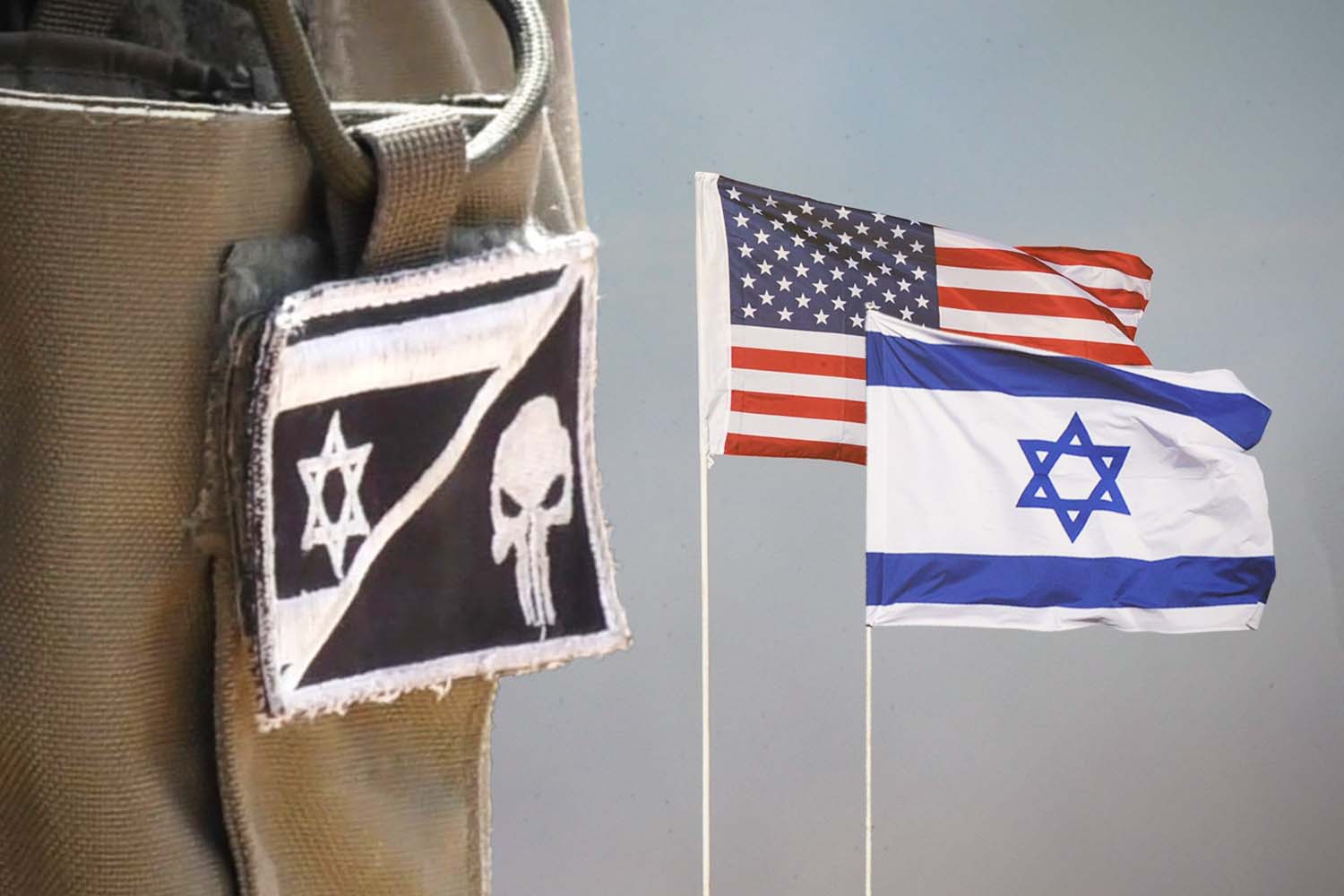Since the early 2000s, an imposing symbol has proliferated throughout military units, police departments, and far-right social movements in the United States. The skull-shaped logo of the Punisher, a Marvel Comics character, has appeared spray-painted on the helmets of American counterinsurgency squads in Iraq and, increasingly, affixed to the uniforms of police officers — including those seen beating and arresting Black Lives Matter protesters on streets across the United States. Today, modified versions of the skull featuring the stars and stripes of the American flag have been widely adopted by the pro-police “Blue Lives Matter” and “Thin Blue Line” movements, militias, QAnon and MAGA devotees, and more.
As +972 Magazine reported last month, Israel security forces have also begun wearing the Punisher logo in recent years. IDF soldiers, police officers, and civilians have all been seen wearing variations of the skull — many incorporating the Israeli flag — while attacking protesters and demolishing Palestinian civilian infrastructure in the occupied West Bank, suppressing summertime protests in Jaffa, expropriating public space for a gated kibbutz, and more. As with the American flag version of the skull, the patches are available to buy online, sold by Israeli and international distributors.
Marvel’s morally ambiguous antihero is a ruthless, hyper-masculine vigilante who routinely disregards legal and ethical convention as he hunts, tortures, and murders arch-villains who are often racialized minorities stereotyped as criminals, drug dealers, and terrorists. Speaking to Vulture magazine in 2020, U.S. military veterans dubiously claimed they keep their admiration for the character “safely in the realm of fantasy,” and that the Punisher’s ultra-violent, extra-legal escapades “are not ones to emulate.”
In Israel, meanwhile, some observers of the growing phenomenon have offered that Israelis aren’t “really interested in what the Punisher specifically represents, or in the series behind it.” As one Reddit commenter put it, Israeli state forces simply wear the logo “because it looks badass and who doesn’t want to be a cool badass.”

While the American assertion is highly suspect, the Israeli claim, even if true, is in some sense beside the point. In our interconnected world of globalized pop culture and social media, the appeal of iconography such as the Punisher skull spreads across communities and borders and takes on a life of its own, dragging accumulated resonance, ideology, and context in tow. What can the character of the Punisher — with its aggressive machismo, its glorification of violence, and its uncompromising disdain for minimal standards of law and human rights — tell us about the American and Israeli state forces and social movements who proudly align with it?
The wish-fulfillment of white supremacy
The Punisher, which debuted in 1974, tells the story of Frank Castle — a vengeful military veteran who, upon returning home from the Vietnam War, witnessed the murder of his wife and children by the Mafia, and committed himself to a life of vigilante justice. The Punisher is a tortured, besieged, solitary actor, armed with considerable military expertise, a black-and-white view of “good” and “evil,” and an unflinching certainty that the end always justifies the means. He readily disregards the law and resorts to sadistic acts of coercion, blackmail, and killing sprees against the villains he pursues.
The Punisher embodies a fantasy “of the skills of war released from institutional control,” explained Steven Gardiner, U.S. Army veteran, cultural anthropologist specializing in military masculinities, and Research Director at Political Research Associates (PRA), a progressive think tank studying right-wing movements. (Full disclosure: the author of this piece is an employee at PRA.)
“It’s a kind of juvenile fantasy of simplification: bad guys exist, I will kill them — and no one is going to stop me,” Gardiner said. “As a symbol, it is both meant to intimidate enemies and at the same time acts as a not-so-subtle critique of institutions. Hence its easy adoption by both active duty soldiers and cops on the one hand, and on the other hand militia members with an explicitly anti-government ideology.”
It is no surprise that the Punisher has emerged as a central totem of the militant American far right: he models an aggrieved, resentment-fueled hypermasculinity and a Machiavellian morality; has a penchant for targeting Black and brown communities in his ultra-violent crosshairs; and wears a skull logo partially inspired by the Totenkopf once sported by the German military and adopted by the Nazi SS, and now favored by contemporary white nationalists. From its emergence in the tumultuous post-Vietnam era, the Punisher was “kind of in the Zeitgeist,” explained character co-creator Gerry Conway (who has harshly criticized its use by police), expressing “a sense of society being out of control” and conservative longing for “a vigilante coming in and restoring order by taking on the role that institutions had failed to perform.”

Throughout the 1980s and 1990s, as the Reagan-era “war on drugs” subjected Black and Latinx communities to intensified societal scapegoating, mass incarceration, and police violence, the Punisher regularly hunted down racist caricatures of the same communities across America’s inner cities and in South America, mocked Black victims of police brutality, and otherwise acted out, through violent fantasy, the wish-fulfillment of the racist aggression animating U.S. policy of the era.
During the U.S. invasion of Iraq in 2003, the Punisher leapt from the pages of America’s comic books to the frontlines of its so-called war on terror, utilized by U.S. military forces as a weapon of psychological warfare against a new racial “other.” “We spray-painted it on our Hummers and body armor, and our helmets and all our guns. And we spray-painted it on every building or wall we could. We wanted people to know, We’re here and we want to f**k with you,” recalled veteran Chris Kyle, hero of the film “American Sniper,” in his autobiography.
American police officers began utilizing the Punisher as early as 2004, when a rogue group of Milwaukee officers, later investigated for the brutal beating of an unarmed Black man, formed a vigilante squad known as “the Punishers,” and wore black gloves and caps embossed with skull emblems while on patrol.
Since the rise of the Black Lives Matter movement in 2014, the Punisher has increasingly become a patron saint of reactionary policing in the United States. Police departments have emblazoned the logo on the hoods of squad cars; police unions have used it for social media campaigns with their members; cops have worn the logo while beating and arresting protesters; and innumerable “Thin Blue Line” and “Blue Lives Matter” groups have displayed it prominently on websites and apparel, and at protests and gatherings.
In a telling 1991 strip, the Punisher’s hard-edged anti-establishment bent would foreshadow future developments on the American right. “The real enemy’s in Washington!” he declared. “Liberal Democrats have sold this country down the river! You know what would make a difference? Blowing away a few crooked congressmen… yeah… I’d even kill a few Republicans just to show I’m bi-partisan.” Two decades later, in the midst of the Capitol insurrection, at least two rioters equipped with heavy tactical gear and zip ties stormed the inner chambers of the Capitol building with Punisher logos on their military vests — on the hunt, apparently, for members of Congress.
By this time, the Punisher had long been taken up as a fixture on the American far right, used in association with QAnon, boogaloo and militia movements, at the alt-right “Unite the Right” rally in Charlottesville, Va., and elsewhere. As has been well-documented, these movements are, in the main, deeply antisemitic — from the white nationalist chants of “Jews will not replace us” at Charlottesville to the warmed-over blood libel conspiracies of QAnon.

Hypermasculinity under siege
In the United States, police and military forces are radicalizing rightwards, with repeated cases of officers and soldiers embracing white nationalism and conspiracy theories such as QAnon, and collaborating with Proud Boys, militias, and other street-fighting rightists in violent repression against Black Lives Matter protesters. In Israel, too, soldiers, police, settlers, and far-right movements increasingly collaborate to violently repress Palestinian communities and solidarity movements — a trend on full display during and since last spring’s war on Gaza.
In both contexts, the Punisher logo knits together these military and police units, rightist social movements, and swathes of the general public in a broad, reactionary cultural nexus — a process deeply entrenched in the United States, but beginning to spread in Israel as well; in late June, for example, the skull was spotted on one of a small group of black-shirted Israelis, who were defending a historically Ashkenazi kibbutz amidst Mizrahi-led protests over land use and exclusion.
Here, as with its use elsewhere, the skull and bared teeth of the logo symbolize the politics of grievance at work in violent efforts to reinforce supremacist dominance against challenges from below, in moments of political transformation, instability, and heightened tension. To this end, the logo’s appeal in the United States is nourished by its roots in a broader culture of alienation and aggression, gun violence, toxic masculinity, and the militarization of everyday life — a culture which finds ready parallels in Israel, where the ubiquity of occupation, settler-colonial dominance, and hyper-militarization has blurred the boundary between battleground and home front, military and civilian life.
Moreover, as comic artist Nate Powell explained in a 2019 comic essay, the image of the Punisher — an alienated veteran rebelling against the corrupt establishment which betrayed him — serves as “a lost cause fantasy…asserting a narrative of eternal innocence [and] nobility,” a powerful victimization narrative for resentment-fueled toxic masculinity on the American right, and for U.S. veterans in particular. Like so much else on the right, wearing the Punisher logo allows the individual cop, soldier, or militia member to collectivize private grievance, to bind themselves to an imagined community of “lone wolf” warriors, united in quiet suffering and grim vengeance.
While the cultural context is distinct, in Israel, too, a pervasive sense of victimization and abandonment — a conviction that “the whole world is against us” — helps prop up a parallel investment in resentful hypermasculinity. Amid a belief that Israel is at once the defender, perched on the edge of Europe, of “western civilization,” and also utterly misunderstood by the world, a national self-image of the besieged, lonely warrior has taken root — one who, like the Punisher, must endlessly pursue a dogged enemy, and for whom human rights are a mere indulgence.
In this vein, the spread of the Punisher logo in Israel also marks a new phase in Zionism’s long and complicated relationship with Western masculinity. As scholar Daniel Boyarin documented in “Unheroic Conduct: The Rise of Heterosexuality and the Invention of the Jewish Man,” many early-20th century Zionist leaders and ideologues were enamored with cultural codes of domineering warrior-masculinity then on the rise across nationalist Europe; accordingly, they urged Jewish communities not only to emigrate to Palestine, but also to transform themselves, in so doing, into “Muscle Jews.”

This Zionist “negation of the diaspora” internalized European antisemitic stereotypes of Jewish men as weak, effeminate, and passive, fashioning the “new Jew” in shame-ridden rejection of this image. In many ways, today’s Israeli “Punishers” and Proud Boys are again gazing longingly at the nationalist, antisemitic West, this time assimilating motifs of military hypermasculinity from the American white supremacist vanguard.
Beyond the Law
Alongside mimicking templates of Western masculinity, the use of the Punisher logo in Israel by military and police forces also channels state repression, violence, and terror against racialized “others,” much as it does in the United States. “When you use a skull,” Israeli activist Avner Wishnitzer told +972 last month, “the immediate context is death — you don’t need too much cultural mediation here. This is what these soldiers want to convey.”
The increasing sight of Israeli soldiers, police officers, and civilian mobs wearing the skull — often while brutally repressing Palestinian and Mizrahi communities and protest movements — acts as a visual shorthand for using unbridled aggression to secure and maintain dominance by “any means necessary,” borrowing the language one enthusiastic U.S. police chief used to defend the Punisher logo.
Indeed, soldiers and police officers in both countries admire the Punisher precisely because, much like the tortured heroes of Israeli counterterrorism dramas such as “Fauda” or U.S. shows such as “24,” he effortlessly casts off any restraint that might be imposed by the criminal justice system, and takes justice into his own hands.

“Frank Castle does to bad guys and girls what we sometimes wish we could legally do…[he] doesn’t see shades of grey,” a U.S. prison guard and freelance security officer told Vulture in 2020. “He has a job to do and he does it,” elaborated another Marine vet. “No political correctness, no rules other than his own, he just does what needs to be done. Period.” It is not hard to find such sentiments also articulated in the Israeli arena, such as when the prominent journalist Ben Caspit responded to the 2017 arrest of Palestinian activist Ahed Tamimi by suggesting that Israel “exact a price at some other opportunity, in the dark, without witnesses and cameras.”
The idea of the Punisher as super-vigilante, PRA’s Gardiner explained, “rests on the premise that the reason military or police violence is not effective in bringing about desired ends…is because violence has been somehow restrained by ‘liberal,’ ‘civilian’ authorities who lack the masculine toughness to do what is required…if only, the logic follows, we could just kill them all.”
Wearing the Punisher logo while on duty thus helps American and Israeli state forces to view themselves, counterintuitively, as vigilante outlaws: to grant themselves collective permission to transcend, in the name of violent repression, the very law they ostensibly serve to protect — and to bear witness, in the process, to the racist violence at the very heart of the unjust status quo. For state forces in both countries, who are regularly criticized for flouting basic human rights standards, the appeal of the Punisher is hard to miss.
The Deadly Exchange
Activists from the United States to Israel/Palestine have long drawn attention to the “deadly exchange” of tactics and technologies of state repression, developed and shared between police and military forces of both countries. The spread of the Punisher logo shows that the “deadly exchange” is one of aesthetics and symbology as well — a cultural transfer accelerated by the growth of social media and incubated within a global far-right movement, a “nationalist international” within which the Israeli and U.S. right are central players.

The Punisher, explained character co-creator Gerry Conway, is “someone that arises from our subconscious and acts on our behalf…he is a symbol, really, of cultural breakdown.” Today, as the tensions and contradictions generated by settler-colonial and racial domination in the United States and Israel reach a breaking point — with growing movements for justice, equality, and transformation met with severe backlash from an emboldened right in both countries — the Punisher has, in many ways, arrived right on time.
Its proliferation is countered, however, by the spread of solidarity between Palestinians and Black Americans, and between social movements in both countries united by a shared vision of liberation, freedom, and a better, more equal world.

